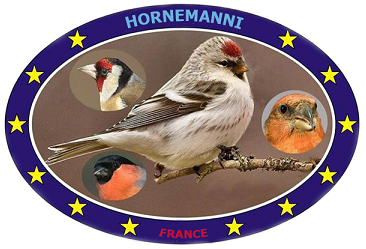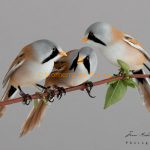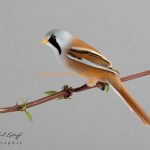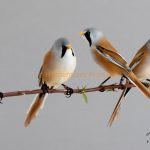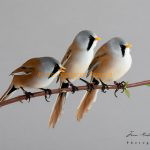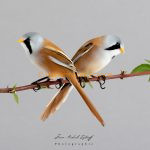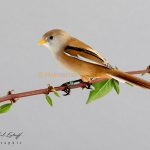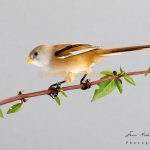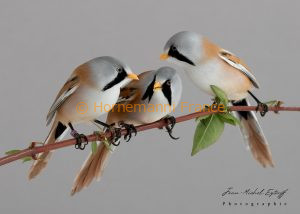
Description
The photos speak for themselves. The male has a distinctive head pattern with two black lines, earning the species its name of moustached parsnip. The female does not have this characteristic.
Location and habitat
Moustached geese live in large reedbeds and near ponds. In France, they are found mainly on the coast.
Regulatory status
-Protected species. All wild specimens are considered protected. There is no mutation recognised as domestic for this species.
-A certificate of competence is required for quota 1.
-The keeping of a single subject implies compliance with the regulations in force
-A licence to open a breeding establishment is required for quota 1
-IFAP registration
-All birds held must be identified with a closed band appropriate to the diameter of the species or subspecies.
-Transfer only between authorised persons with marking certificate (cerfa)
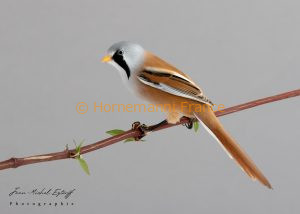

OMJ standard
Body size: 16/17cm.
Round, massive head, rounded body, long tapering tail
Head hooded in luminous grey
On each side of the beak, vertical black moustache-like patterns, encompassing the eye and tapering to the bottom of the throat.
White chin and throat
Nape and side of neck grey like the head, clearly defined by the reddish-brown colour of the back
Reddish-brown back clearly defined by a white line running from the shoulder along the contour of the wing.
Chest, throat Throat, chest and belly white down to the anal region
Sides Buff brown, widening towards the belly and lower part of the body
Belly, anal region Russet white
Wings Reddish-brown coverts, the folds close to the wing are marked with black.
The first four large wing feathers are white with black markings at the base and tip.
The other wing feathers are reddish-brown, those closest to the back are partially black, forming a black line next to the white line on the back
Rump Black brown
Tail Reddish-brown rectrices, the outer rectrices are fringed with black.
Beak Yellow, fairly curved, fine and pointed
Eyes Yellow eye rims. Black centre
Legs, toes black
Nails black
Remarks: The female has an unpatterned, creamy-beige head, with greyish cream cheeks. The rest of the plumage is identical to that of the male, with duller colours and the possibility of blackish marks on the head and lower back.
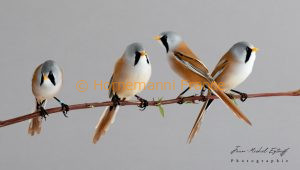
Breeding conditions:
The pair is placed in a small aviary 1m X 2m X 1m from winter onwards. Larger planted areas can also be used as long as there are no other chickadees in the aviary.
In an indoor aviary, I use bamboo branches and reeds to tree the breeding area. Wicker nests in the shape of a drop are camouflaged there. In the wild, they weave a nest in the reeds.
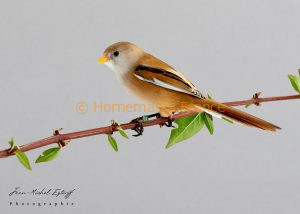
Nesting materials :
Coconut fibre, cotton, horse and goat hair, feathers
Breeding behaviour
The pair is very close. The two parents take turns incubating the eggs. An average of 5 eggs are laid.
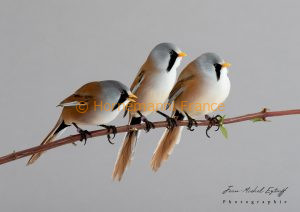
Dry feed
I use two types of pate. One for Japanese nightingales, and one enriched with dehydrated insects for fine beaks. Extruded NutriBird Uni Komplet maintenance pellets for small frugivores and insectivores from Versele Laga are given to the birds at all times.
Supplier description:
– suitable for small frugivorous, nectarivorous and insectivorous birds
– complete, balanced food
– pellets with a scientifically justified composition, based on selected seeds and lots of fresh fruit
– completely edible, no waste
– contains Florastimul: stimulates intestinal flora and protects against intestinal disorders
– promotes beautiful plumage
– optimum calcium/phosphorus ratio for healthy bones
I also give waved parakeet mix and red and red millet.
Live or frozen food
During the winter, I feed live mini mealworms or buffalo worms. When feeding the young, the parents have live insects 3 times a day. Thawed pinckies are used but not with the same interest. Some females spend their time looking for insects in the aviary, a sign that the food is not suitable for breeding. Generally, when this behaviour is noted, the brood has failed.
Banding the young
This is a delicate moment because the nest is not necessarily accessible. Rings 2.5 to 2.7mm. But sometimes you have to resign yourself to ringing the birds as they leave the nest.
Weaning the young
Between 15 and 20 days after birth, the young leave the nest. They stay close together, often huddled together on a branch. The chicks can be sexed as soon as they leave the nest. Males have a flesh-colored beak and females a greyish beak. The young will be independent after a month. During weaning, animal feed is reduced in favour of insectivorous mash.
Juveniles have predominantly beige-brown plumage. Males have no moustache.
Exhibition
These are not difficult birds to show. They just need to get used to the show cage. When I judge this species in a show, whether it’s an international or a world show, this species is often one of the contenders for victory.
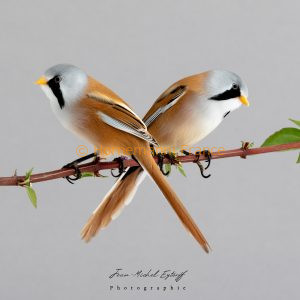
Jean-Michel EYTORFF
